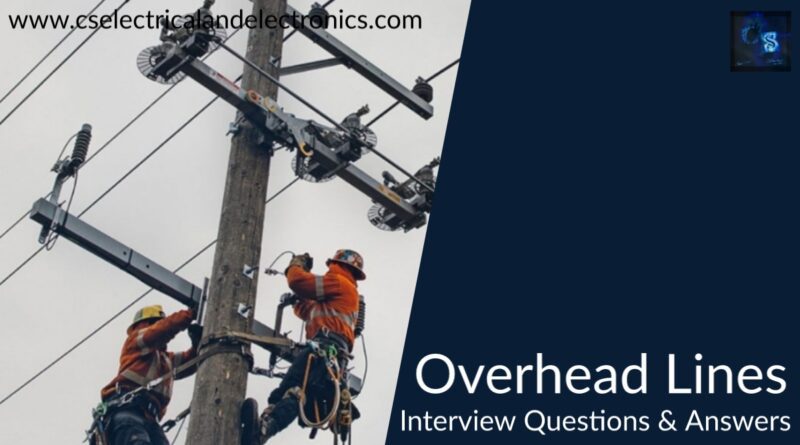Overhead Lines Interview Question And Answer For Engineers
Hello Guys, welcome back to our blog. In this article, we will discuss the overhead lines interview question and answer, and the overhead lines interview questions with answers mentioned here are mostly repeated interview questions.
If you have any electrical, electronics, and computer science doubts, then ask questions. You can also catch me on Instagram – CS Electrical & Electronics.
Also, read:
- Top 20 AUTOSAR Interview Questions For AUTOSAR Engineers
- Top Electric Vehicle Interview Questions With Answers Must Know
- Top 22 MATLAB Simulink Interview Questions And Answers
Overhead Lines Interview Question And Answer
01. What are the drawbacks of wooden poles?
A. The main drawbacks of the wooden poles are comparatively smaller life, poor mechanical strength, the tendency to rot below ground level, and the requirement for a periodical inspection.
02. On what factor does the height of a pole used in a distribution line depend?
A. The height of a pole used in a distribution line depends upon the following factors :
- a. The minimum clearance of the lowest conductor from the ground.
- b. The number of conductors to be carried and minimum vertical clearance between conductors and c. The length of the pole to be buried in the ground (about one-sixth of the total length to be buried in the soil is normal).
03. What are the main requirements for good conductor material used for overhead lines?
A. The main requirements of good conductor material used for overhead lines are high electrical conductivity, high tensile strength, low specific gravity, low cost, easy availability, free from brittleness, and the material should not react with the atmospheric condition.
04. Why are conductors in the transmission line stranded?
A. All conductors used for overhead transmission lines are stranded so as to increase flexibility. Solid wires, except for smaller sizes, are difficult to handle when used for long spans and tend to crystallize at the points of support because of swinging in winds.
05. Why copper conductor is not used for transmission lines?
A. Owing to the difficulty of importing it because of a lack of foreign exchange in our country.
06. What is the function of the cross arm in the overhead line?
A. The function of the cross arm in the overhead line is to keep the line conductors at a safe distance from each other and from the pole.
07. What are the important properties that overhead line insulators must have?
A. The most important properties that an overhead line insulator must possess are High mechanical strength, high relative permittivity, high insulation resistance, high ratio of rupturing strength to flash-over voltage, and capability of withstanding temperature variations.
08. How does insulation fail?
A. The electric failure of insulation may occur either by puncture or flash-over. In the case of a puncture, the arc passes through the insulator body while flashover is caused by an arc discharge between the line conductor and earth through the air surrounding the insulator.
09. Why the use of pin-type insulators is restricted up to 50 KV?
A. Because beyond the voltage of 50 KV the pin-type insulators become bulky, cumbersome, and costly.
10. where and why strain insulators are used?
A. When there is the dead-end of the line, or there is a corner or a sharp curve, or the line crosses the river, etc, the line is subjected to greater tension. Pin-type insulators are used if the voltage is below 33 KV. For low-voltage lines (say, up to 11,000 V), shackle insulators can be used, but for higher voltage transmission lines strain insulators consisting of an assembly of suspension-type insulators are used.
11. Where egg type insulators provided?
A. Egg-type insulators, also called strain insulators, are used in guy cables, where it is necessary to insulate the lower part of the guy cable from the pole.
12. Where stay sets are provided in overhead lines?
A. It becomes essential to provide stay sets in overhead lines to stay supports at angle and terminal positions as the supports take the pull due to conductors.
13. Why phase plates are provided in overhead lines?
A. To distinguish different phases.
14. Why barbed wire is provided on poles?
A. To safeguard against the climbing of unauthorized persons.
15. Why the earthing of the transmission line is necessary?
A. The earthing is done (a). to ensure that no current-carrying conductor rises to a greater potential with respect to the general mass of earth than its designed insulation and (b). to ensure that the potential of non-current carrying metalwork does not rise to a value such that a person may get shocked by touching it.
The supply system neutral point is earthed at a power station or substation to serve the former purpose whereas the latter purpose is served by the regulations which specify that all non-current carrying metalwork of high voltage lines shall be permanently and effectively connected to the earth. For this purpose a continuous earth wire shall be run and connected to earth at four points every 1.6 KM, the spacing between the points being as nearly equal as possible, or alternatively, the metalwork shall be connected to an effective earthing device at each individual support.
16. What is the voltage that has been selected for HVDC transmission?
A. + or – 500 KV.
17. What is an electric power system?
A. The system of generation, transmission, and distribution of electrical power is called an electrical power supply system.
18. What is the usable voltage for secondary distribution?
A. 415/240 V (415 volts for three-phase loads and 240 V for single-phase loads).
19. What is the legal requirement to which a distributor is subjected?
A. A distributor is subjected to the legal requirement that the voltage at the consumer’s terminals should be maintained within + or – 6 % of the declared ( or rated ) voltage.
20. The underground system has numerous advantages over the overhead system for the transmission of electrical power but is less frequently used. why?
A. Because of the higher cost.
21. What are the various components of overhead lines?
A. The main components of an overhead line are supports or towers, cross arms, clamps, insulators, conductors, guys and stays, lightning arresters, earth wires, V-guards, guard wires, phase plates, bird guards, danger plates, anti-climbing devices, vibration dampers.
22. What is the function of line supports?
A. The function of line support is to support the line conductors and keep them at a safe distance from the ground.
23. What are the main requirements of line support?
A. The main requirements of line supports are high mechanical strength, lighter weight, low maintenance cost, longer life, cheaper in cost, good appearance, easy accessibility for painting and erection of line conductors, and immune to damage from lightning and free.
24. What are the four types of line supports?
A. The four types of line supports are wooden poles, RCC or PCC poles, rail poles, and steel structures or towers.
25. Wooden poles are commonly used for rural electrification. why?
A. Because of the low cost.
26. Why steel towers are required to be painted or galvanized regularly?
A. For protection against corrosion.
27. What for the ACSR conductor stands?
A. ACSR stands for aluminum conductor steel reinforced.\\
28. What are the factors on which conductor spacing and ground clearance depend?
A. Factors affecting conductor spacing are voltage while factors affecting ground clearance are voltage and area (living or non-living, urban or suburban, along the streets or across the streets, river crossings/hill crossings, railway track/bridge, etc).
29. What types of insulators are used for overhead transmission and distribution lines?
A. The insulators used for overhead lines are pin type, suspension type, strain type, and shackle insulators.
30. Why insulators are provided on overhead lines?
A. To avoid current leakage from line conductors to the earth through line supports.
31. Where and why suspension-type insulators are used?
A. Beyond voltage of 33 KV, the pin-type insulators become bulky to use and also costly.
32. Why lightning arresters are used in transmission lines?
A. To protect the electrical equipment from damage due to lighting.
This was about “Overhead Lines Interview Question And Answer“. I hope this article may help you all a lot. Thank You For Reading.
Tags: Question And Answer On Overhead Lines, Electrical interview questions, MCQ questions related to TDU, Overhead lines interview questions.
Also, read:
- 10 Tips To Maintain Battery For Long Life, Battery Maintainance
- 10 Tips To Save Electricity Bills, Save Money By Saving Electricity
- 100 (AI) Artificial Intelligence Applications In The Automotive Industry
- 100 + Electrical Engineering Projects For Students, Engineers
- 1000+ Control System Quiz, Top MCQ On Control System
- 1000+ Electrical Machines Quiz, Top MCQs On Electrical Machines
- 1000+ MATLAB Simulink Projects For MTech, Engineering Students
- 50 Tips To Save Electricity At Home, Shop, Industry, Office
Author Profile
- Chetu
- Interest's ~ Engineering | Entrepreneurship | Politics | History | Travelling | Content Writing | Technology | Cooking
Latest entries
 All PostsApril 13, 2024What Is TCM, Transmission Control Module, Working, Purpose,
All PostsApril 13, 2024What Is TCM, Transmission Control Module, Working, Purpose, All PostsApril 12, 2024Top 100 HiL hardware in loop Interview Questions With Answers For Engineers
All PostsApril 12, 2024Top 100 HiL hardware in loop Interview Questions With Answers For Engineers All PostsMarch 22, 2024Driver Monitoring Systems In Vehicles, Working, Driver Sleepy Alert
All PostsMarch 22, 2024Driver Monitoring Systems In Vehicles, Working, Driver Sleepy Alert All PostsMarch 10, 2024Top 100 Automotive Interview Questions With Answers For Engineers
All PostsMarch 10, 2024Top 100 Automotive Interview Questions With Answers For Engineers








